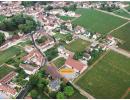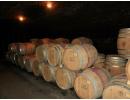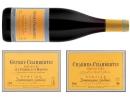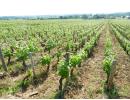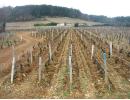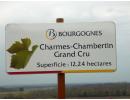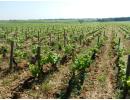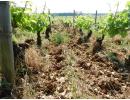Domaine Dominique Gallois
Gevrey-Chambertin 2014
Produced from Pinot Noir vines averaging 50 years of age from 10 plots situated around the village of Gevrey Chambertin. The vines produce an average yield of 40 hl/ha. Following the sorting the grapes are de-stemmed and a pre-fermentation skin maceration for 3 to 5 days will be carried out. Cement vats are used for the fermentations that will last for 10 to 14 days at about 28°C. The ageing in oak barrels will last 16 to 18 months, 10% of barrels are new and 90% are 1 and 2 years old. On average 10,000 bottles are produced.
PVins notes: Dark berries on the nose with slight hints of oak in its youth, a well structure medium-bodied Pinot Noir, the oak is well integrated, elegant tannins that will soften with a little cellaring, good length on the finish. The wine may be cellared for up to 10 years depending on the vintage.
Press: Burghound.com 89-91
There is a discreet touch of wood to the overtly earthy and slightly gamy dark berry fruit and humus suffused aromas. The sleek, velvety and delicious medium weight flavors deliver excellent depth and length on the ever-so-mildly austere finale. This is a very fine Gevrey villages and worth checking out plus it should drink well after only a few years of cellaring.
Gevrey-Chambertin 1 Cru "La Combe aux Moines" 2014
Produced from Pinot Noir vines averaging 45+ years of age planted on clayey-limestone soil, the plot only represents 0.50 ha within the "Combe aux Moines" climat. The average yield is 40 hl/ha. Once hand-picked and sorted about 90% of the grapes are destemmed followed by a pre-fermentation skin maceration for 3 to 5 days. Oak vats are used for the fermentations that lasts 10 to 14 days at about 28°C. The ageing in oak barrels will last 16 to 18 months with 40% of new oak and 60% of 1 and 2 year old barrels. On average 2,400 bottles are produced.
PVins notes: A complex and elegant nose of cassis, black cherry with a hint of oak and earthiness. Well-structured and balanced, powerful with some masculine tannins that will elegantly soften with a little cellaring, great length on the finish. The wine may be cellared for 10 to 15 years depending on the vintage.
Press: Burghound.com 91-93
2014 - As is usually the case this is the best of the Gallois 1ers with its beautifully complex if not especially elegant nose that blends notes of wood with earth, cassis, black cherry and a hint of underbrush. There is excellent power and volume to the slightly less well-detailed big-bodied flavors that also possess evident muscle on the mildly rustic and austere finale that delivers terrific length.
Charmes-Chambertin Grand Cru 2014
Produced from Pinot Noir vines averaging 100 years old, the oldest were planted in 1910. The plot only represents 0.30 ha within the Grand Cru parcel. The average yield is 35 hl/ha. Once hand-picked and sorted about 90% of the grapes are de-stemmed followed by a pre-fermentation skin maceration for 3 to 5 days. An oak vat is used for the fermentations that lasts 10 to 14 days at about 28°C. The ageing in oak barrels will last 16 to 18 months with 75% to 100% of new oak barrels depending on the vintage. On average 1,600 bottles are produced.
PVins notes: A wine that has the power of Chambertin and the roundness of Griotte-Chambertin, both neighbouring Grand Cru. Great aromas of red cherry with some earthiness and a hint of well integrated oak. Pleasantly textured, medium-bodied, well-balanced by the freshness, concentration on the mid-palate, the finish is long and complex. A few years of cellaring is recommended for it to express its full potential. A Grand Cru that will age gracefully over 15+ years.
Press: Burghound.com 93
Once again there is enough wood to notice but not so much as to intrude on the wonderfully fresh and airy aromas of red cherry, pomegranate, earth and a hint of the sauvage. The seductively textured and lush medium-bodied flavors possess an abundance of energy on the lightly mineral-inflected, sappy and impeccably well-balanced finale that also reflects a touch of youthful austerity.
Domaine Gallois started in 1901 when Dominique Gallois’s great grand-father Mr Bizot established a cellar in Grevrey-Chambertin. In those days the estate had multiple vineyards as far south as Volnay. Later the estate was divided between the family members with Charlotte GALLOIS inheriting 2.5 hectares of vineyards in the appellation of Gevrey-Chambertin. Her son Jean GALLOIS then looked after the estate until 1989. At the age of 30 Dominique, Jean’s son, took over the estate and decided to estate bottle the wines that he would produce. In 2011 a new cellar came into operation to improve the winemaking process.
The 4 ha of Domaine GALLOIS are made up of various parcels. The breakdown on their size and locations are: Bourgogne 0.50 ha (Pinot Noir / Chardonnay) – Gevrey-Chambertin 2.20 ha made up of 10 parcels - Gevrey-Chambertin 1 Cru only 1 ha made up of 3 parcels in 3 different climats “La Combe aux Moines” planted in 1954, “Les Goulots” planted in 1974 and “Les Petits Cazetiers” planted in 1959 - Charmes-Chambertin Grand Cru 0.30 ha planted in 1910, some vines have recently been replaced.
The Gevrey Chambertin is a blend of 10 plots situated around the village of Gevrey Chambertin. The plots are small therefore it is not possible to make individual wines for each lieu-dit. The Domaine's vines are on average 50 years old.
Domaine Gallois' three Gevrey Chambertin 1 Cru vineyards are located in 3 separate climat “La Combe aux Moines”, “Les Goulots” and “Les Petits Cazetiers” which are next to each other. They are located on the eastern side of the appellation facing east and situated towards the top of the hill on a steep slope at 340 to 380 metres in altitude. The wines from this area are well structured, powerful with a great ageing potential. Each climat has its own little story, for example the 1er Cru “Combe aux Moines” a “Combe” is a little valley and “Aux Moines” means of monks. It is believed that the first monks in the area, during the 7th century, were already cultivating the vineyard of this climat and later it belonged to the Abbey of Cluny until the French Revolution. The wines from this area have always been sort after for their quality.
Charmes-Chambertin is a Grand Cru of 12.24 ha at an altitude of 260 metres in which Domaine Gallois has a small plot of 0.30 ha, with vines reaching 100 years old. The plot is located near the Griotte-Chambertin Grand Cru and below the Chambertin Grand Cru. The soil structure is clayey-limestone with small limestone fragments, including marl and iron as the soil is redish in colour, the mother rock is not far below. Charmes Chambertin is considered to be one of the most complex Burgundy wines after cellaring when it is produced from old vines from the best parcels in excellent vintages. This is the reason why it is named "Charmes" meaning charm.
The Domaine is sustainably farmed, grass is left to grow between the rows for bio-diversity and health of the parcels. The ploughing between the rows is done the old way with a horse. Canopy management and green harvest are practiced when necessary and only Pinot Noir is planted as per the appellation's regulation.
The harvest is hand-picked and a first sorting of grapes will be done in the vineyards by the pickers, then a second "tri" will be carried out at the cellar on arrival on a sorting table. Grapes are destemmed with 10% left as whole bunches for the 1er Cru and Grand Cru. A cold pre-fermentation skin-maceration is carried out that will last 2 to 5 days to extract a little extra colour, flavours and give the structure a little boost. For the fermentations both stainless steel vats and cement vats are used, which will last for 10 to 14 days depending on the vintage, only indigenous yeasts are used. The wines are barrel aged in the underground cellar for a period of 16 to 18 months. The percentage of new oak used can range from 10% for the Gevrey Chambertin to 40% for the 1er Cru and 100% for the Charmes Chanmbertin depending on the potential of the vintage.
In general, the wines are never over powered by oaky aromas and flavours, showing the characteristics of the Pinot Noir and each climat's terroir. They are well-balanced and structured, the wines of Dominique Gallois are a very good representation of the appellation Gevrey Chambertin. A couple of years of cellaring is recommended before appreciating the full potential of the wines, they may be cellared for 10+ years depending on the wine and vintage.
The Domaine also produces a Bourgogne Chardonnay of which only 1,200 bottles are made from a parcel on the commune of Couchey.
Links: AOP Gevrey Chambertin - AOP Charmes Chambertin - Cote de Nuits map - www.bourgogne-wines.com
GEVREY CHAMBERTIN
The Gevrey-Chambertin appellation is located in the Côte de Nuits district of Burgundy and dates from September 1936 with the Grand Cru classification dated July 1937. The appellation spreads over the 2 communes of Gevrey-Chambertin and Brochon covering 491.22 hectares. The vineyards are mainly located on the commune of Gevrey while Brochon accounts for 51 hectares with only one 1er Cru. The appellation's 9 Grands Crus, with the well-known Chambertin and Clos de Bèzeare, are located on the commune of Gevrey-Chambertin to the south of the village representing 88.50 hectares, while the 26 Premiers Crus known as "Climats" represent 86 hectares.
History
Its vineyards can be traced back to the year 640 AD when Clos de Bèze was a monastic property. The name Chambertin has been used since the 13th century and Napoleon Bonaparte was known to drink nothing else but Chambertin wines.
Vineyard
The various terroirs can be described as follow: On the upper portion are brown soils, partly alluvial, partly scree which can reach tens of centimetres in depth on top of the limestone mother rock. Lower down are clay-limestone soils in varying proportions. Up-slope, the rocks are of bathonien origin, lower down the marls and limestones belong to the Jurassic (Bajocian) and numerous marine fossils are to be found on the surface, recalling that the sea covered this area some 150 million years ago. Vine exposure varies from east to south-east. The Grands Crus are situated from mid to the upper area of the slope, while the 1er Crus, mainly to the east of the village, occupy the upper portion of the slopes at heights of between 280 and 380 metres.
Pinot Noir is the only grape allowed in the appellation, its colour is bright ruby, turning to deep carmine or dark cherry with age. On the palate, the wines impress by their firm structure, velvety tannins and delicate texture. These wines are everything a great burgundy should be: full-bodied, powerful, rich, and meaty. Pleasant when drunk young, on the fruit, they are nevertheless first and foremost wines for ageing, often for long periods. The terroirs stony mixtures confer elegance and delicacy on the wine while the clayey marls, which contain rich deposits of fossil shell-fish add body and firmness to the wines structure.
Climate
The Côte d'Or is on the 47th parallel and the climate is classed as Continental, meaning winters (Dec-Jan-Feb.) can often be very cold with late frosts and summers (Jun-Jul-Aug) curiously like that of Bordeaux can occasionally reach extremely high temperatures. Micro-climates are another significant factor in the region as the heart of the Burgundian vineyards stretch over 50 kilometres from Dijon in the north to Chagny in the south. Most of the vineyards face east or east-south-east, benefiting from the morning sun. The vines are also sheltered by the hills from the wet westerly winds and because of their altitude they are not affected by fog and frost damage that occurs on the plains, but they might still be occasionally covered in snow during winter.




